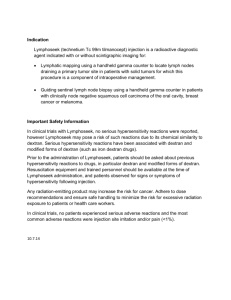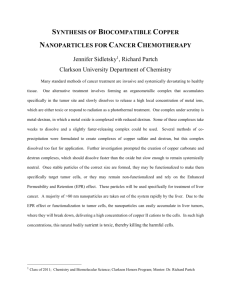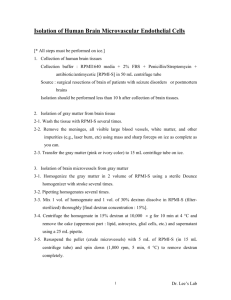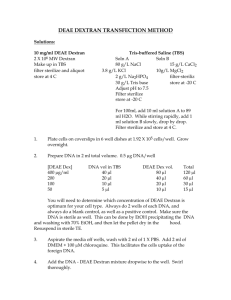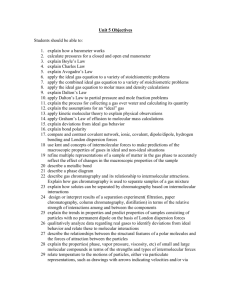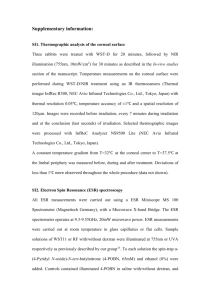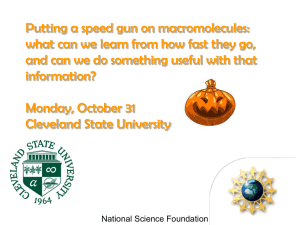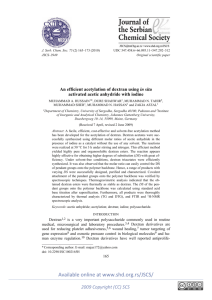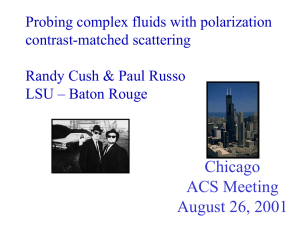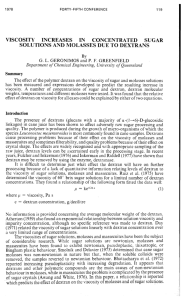Blue-dextran
advertisement
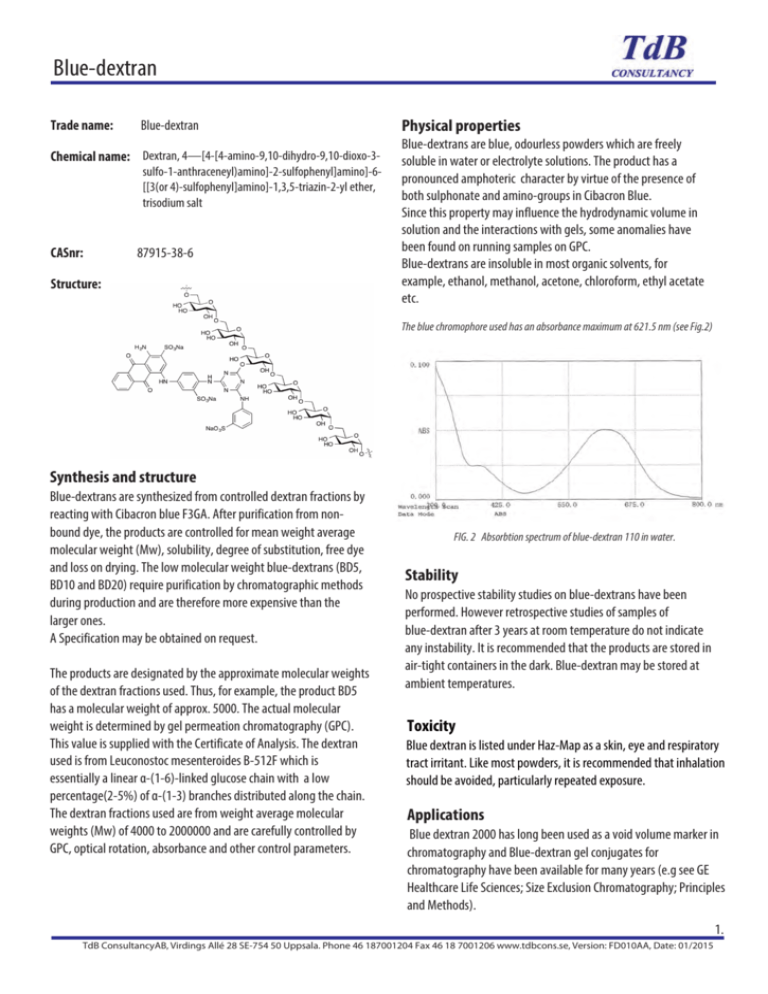
Blue-dextran Trade name: Blue-dextran Chemical name: Dextran, 4—[4-[4-amino-9,10-dihydro-9,10-dioxo-3- sulfo-1-anthraceneyl)amino]-2-sulfophenyl]amino]-6[[3(or 4)-sulfophenyl]amino]-1,3,5-triazin-2-yl ether, trisodium salt CASnr: 87915-38-6 Structure: Physical properties Blue-dextrans are blue, odourless powders which are freely soluble in water or electrolyte solutions. The product has a pronounced amphoteric character by virtue of the presence of both sulphonate and amino-groups in Cibacron Blue. Since this property may influence the hydrodynamic volume in solution and the interactions with gels, some anomalies have been found on running samples on GPC. Blue-dextrans are insoluble in most organic solvents, for example, ethanol, methanol, acetone, chloroform, ethyl acetate etc. The blue chromophore used has an absorbance maximum at 621.5 nm (see Fig.2) Fig. 1 . Fragment of a Blue-dextran chain Synthesis and structure Blue-dextrans are synthesized from controlled dextran fractions by reacting with Cibacron blue F3GA. After purification from nonbound dye, the products are controlled for mean weight average molecular weight (Mw), solubility, degree of substitution, free dye and loss on drying. The low molecular weight blue-dextrans (BD5, BD10 and BD20) require purification by chromatographic methods during production and are therefore more expensive than the larger ones. A Specification may be obtained on request. The products are designated by the approximate molecular weights of the dextran fractions used. Thus, for example, the product BD5 has a molecular weight of approx. 5000. The actual molecular weight is determined by gel permeation chromatography (GPC). This value is supplied with the Certificate of Analysis. The dextran used is from Leuconostoc mesenteroides B-512F which is essentially a linear α-(1-6)-linked glucose chain with a low percentage(2-5%) of α-(1-3) branches distributed along the chain. The dextran fractions used are from weight average molecular weights (Mw) of 4000 to 2000000 and are carefully controlled by GPC, optical rotation, absorbance and other control parameters. FIG. 2 Absorbtion spectrum of blue-dextran 110 in water. Stability No prospective stability studies on blue-dextrans have been performed. However retrospective studies of samples of blue-dextran after 3 years at room temperature do not indicate any instability. It is recommended that the products are stored in air-tight containers in the dark. Blue-dextran may be stored at ambient temperatures. Toxicity Blue dextran is listed under Haz-Map as a skin, eye and respiratory tract irritant. Like most powders, it is recommended that inhalation should be avoided, particularly repeated exposure. Applications Blue dextran 2000 has long been used as a void volume marker in chromatography and Blue-dextran gel conjugates for chromatography have been available for many years (e.g see GE Healthcare Life Sciences; Size Exclusion Chromatography; Principles and Methods). 1. TdB ConsultancyAB, Virdings Allé 28 SE-754 50 Uppsala. Phone 46 187001204 Fax 46 18 7001206 www.tdbcons.se, Version: FD010AA, Date: 01/2015 Blue-dextran The blue-dextrans available from TdB Consultancy now extend the range of applications in Biosciences and are detected with standard UV and RI detectors. Other important spheres of research, where blue-dextrans have been used, are listed below. Studies on lysosomal activity(1), endothelial cell permeability(2), bovine sperm permeability(3) , cornea permeability(4), flow studies in lung(5-7) , cerebro-permeability(8-10), binding of proteins and enzymes to Blue-dextran (11-13). References: 1. D.M.Wolfe, J.H.Lee, A.Kumar et al., Autophagy failure in Alzheimers disease and role of defective lysosomal acidification, Eur.J.Neurosci., 2013,37(12), 1949-61. 2. C.M.Waters, J.S.Alexander, T.R.Harris et al., Perilla ketone increases endothelial cell monlayer in vitro, J.Appl.Physiol., 1993,74(5), 24932501. 3. P.K.Schoff and N.L.First, Stimulation of bovine cell motility by the triazine dye cibacron blue F3GA, Mol.Reprod.dev., 1995,42(1), 65-71. 4. R.M.Robbins and M.A.Galin, A model for steroid effects in herpes keratitis, Arch.Ophthalmol., 1975,93(9),828-30. 5. S.T.Ballard and J.T.Gatzy, Volume flow across the alveolar epithelium of adult rat lung, J.Appl.Physiol., 1991,70(4),1665-16676. 6. S.Cassin, Effect of indomethacin on fetal lung liquid formation, Can.J.Physiol.Pharmacol., 1984,62(1),157-9. 7. R.E.Pfister, C.A.Ramsden, H.L.Neil et al., Errors in estimating lung liquid in fetal lambs when using radiolabelled serum albumin and blue dextran, J.Appl.Physiol., 1999, 87(6) 2366-74. 8. C.E.Johanson, Age-related decrease inA-Beta Peptide clearance pathways: CSF and BBB, RePORTER (Database NIH), 9. S.S.Prabhu, Broaddus, G.T.Gillies et al., Distribution of macromolecular dyes in brain using positive pressure. Surg.Neurol., 1998, 50(40) 367-375. 10. L.Z.Bito, H.Davidson and J.R.Hollingsworth, Facilitated transport of prostaglandins across the blood-cerebrospinal fluid an blood-brain barrier, J.Physiol., 1976, 256(2), 273-85. 11. Reshma SV1, Sathyanarayanan N, Nagendra HG, Characterization of hypothetical protein VNG0128C from Halobacterium NRC-1 reveals GALE like activity and its involvement in Leloir pathway of galactose metabolism, J Biomol Struct Dyn. 2014 Nov 14:1-13. 12. G.E.J.Staal, J.F.Koster, H.Kamp et al., Human erythrocyte pyruvate kinase. Its purification and some properties, Biochim.Biophys.Acta, 1971, 227, 86-89. 13. A.C.W.Swart and H.C.Hemker, Separation of blood coagulation factors II,VII,IX and X by gel filtration in the presence of Dextran blue, Biochim.Biophys.Acta, 1970, 222, 692-695. 2. TdB ConsultancyAB, Virdings Allé 28 SE-754 50 Uppsala. Phone 46 187001204 Fax 46 18 7001206 www.tdbcons.se, Version: FD010AA, Date: 01/2015
